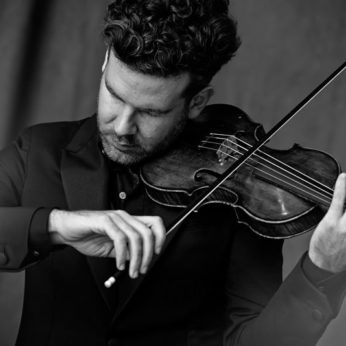Composer: Johann Sebastian Bach (b. 1685 - d. 1750)
Performance date: 25/06/2023
Venue: St. Brendan’s Church
Composition Year: 1725
Duration: 00:14:32
Recording Engineer: Gar Duffy, RTÉ
Instrumentation: vn, hpd
Instrumentation Category:Duo
Artists:
Johannes Pramsohler -
[Violin]
Philippe Grisvard -
[Harpsicord]

‘The six harpsichord trios are amongst the finest works of my dearly beloved father. They still sound excellent and give me great pleasure although they are over 50 years old. There are several Adagios in them which even nowadays could not be set in a more singing style.’ C.P.E.Bach
This quotation by CPE always raises a wry smile from contemporary composers and concert promoters. By trio sonata CPE referred to the three voices – violin, harpsichordist’s right hand and the bass played by the left hand with optional support of a viola da gamba, not present in this performance.
The earliest source for these six works describes them as ‘sonatas for obbligato harpsichord and solo violin with a bass accompanied by a viola da gamba if you like’. They were begun while he was Capellmeister at Cöthen for the music-loving Prince Leopold, who had brought together a highly distinguished ensemble to work with Bach. The presence of these outstanding musicians like Joseph Spiess and Christian Abel inspired much of Bach’s solo instrumental works. The set was completed in Leipzig around 1725 and later revised at least twice. It is interesting to note that these sonatas were among the very first works published in the Nineteenth Century’s Bach revival.
Baroque musicology seems to change on an almost annual basis as new scores, letters and other documents are unearthed in dusty libraries. As we shall discover later in this Festival, Johannes Pramsohler has a particular expertise in dusting off old scores by long-forgotten composers. Very often the only surviving manuscripts are copies made years after the original composition, often creating impossible conundrums for the modern performer. In addition early publishers had a reputation for misattribution, which modern scholars and performers are still sorting out.
This concert is travelling under the heading Bach’s Legacy, an initially puzzling moniker until you realise that the G minor Sonata has been incorrectly attributed to Johann Sebastian although it remains in the BWV (Bach-Werke-Verzeichnis) catalogue. Some experts think the likeliest candidate is one of Bach’s sons, possibly Johann Christoph Friedrich, many of whose manuscripts were destroyed in WWII. This delightful Sonata stands out by having only three movements (fast-slow-fast) and opening with a tremendous harpsichord solo. The Adagio has a gorgeous singing melody and the cheerful final Allegro is just as tuneful.
It is tempting to see the set of six Sonatas as part of the great series of Sixes – the solo violin Sonatas and Partitas, the Cello Suites, the Brandenburgs, the French and English Suites and the harpsichord concertos – as a series of Books to match the sets of 12 Fantasias for flute, violin and gamba by Telemann, an exact contemporary. We can also wonder whether Bach had an ambitious plan hinted at in the Libro Primo title for the solo violin set.
The concert opens with the C minor Sonata, the fourth in the series. The equal nature of the partnership between violin and keyboard is immediately clear. The four movements are in the style of the Italian church sonata, slow-fast-slow-fast. The first movement reveals one of Bach’s great cantilenas, long lines of a Siciliano spun out over broken chords while the Adagio third movement is a calm reflection in the relative major. The Allegros are lively dances where the instruments swap ideas in joyful counterpoint.
The E major Sonata is the high point of the set, demanding extraordinary virtuosity almost reaching the limits of the playable in the spectacular, final Allegro. The opening Adagio shows Bach’s vaunted mastery with the violin’s richly decorated theme soaring above a chorale-like accompaniment from the harpsichord. Listen for the long-held note that gently fades away as the movement ends, leading into one of the happiest fugues you will ever hear. The third movement, Adagio ma non tanto, has the violin’s song unfold over the gentle march of the harpsichord’s distinctive chords, before occasionally changing places. The Finale flies by at reckless speed, dominated by the violin’s motto theme, pausing only for a contrasting middle section that barely slows the hectic pace.
The G major Sonata, the last in the set, chooses to escape the four movement structure with an extra movement for solo harpsichord and the unusual placement of concertante elements. It opens with a flashy and exuberant Allegro invoking the Italian style of Corelli followed briefly by a charming Largo. The central solo harpsichord movement displays something of Bach’s brilliance at the keyboard. The B minor Adagio seems to have dropped in from another world, a deeply serious interlude before the joyous concluding fugue brings the series to a close.
Copyright © 2025 West Cork Music. All rights reserved.
Designed and developed by Matrix Internet